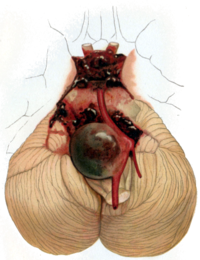
Photo from wikipedia
OBJECTIVE Quality of life is an important factor in the decision making for the treatment of unruptured intracranial aneurysms (UIA). The data dealing with QoL in patients after the treatment… Click to show full abstract
OBJECTIVE Quality of life is an important factor in the decision making for the treatment of unruptured intracranial aneurysms (UIA). The data dealing with QoL in patients after the treatment are spare. We have evaluated QoL of patients after endovascular or surgical treatment of incidental intracranial aneurysm. METHODS We performed a prospective analysis of retrospectively collected data. All patients received 36-Item Short Form Health Survey (SF-36), Hospital Anxiety and Depression Scale (HADS), German questionnaire for self-perceived deficits in attention (FEDA) and not standardized questionnaire analyzing personal job-related situation, family circumstances and chronic illnesses. RESULTS 177 patients were treated during the evaluated period. 79 (44.6%) patients responded. In this cohort, 62.03% of patients underwent coiling. Complications were noted in 13.9% of patients. Stroke was the most common complication (7.6%). All SF-36 related data except for pain showed significant lower mean, if compared to the standard German population (p < 0.01). For both genders, anxiety (males, P = 0.003 and females, P = 0.002) but not depression was more common than in the standard population. According to the FEDA test, treated patients showed significant difference only for fatigue in comparison to healthy population (P < 0.001). 54.4% of patients suffered from chronic illnesses, and among them only 1 patient (1.3%) had aneurysm associated chronic disease. No significant differences were found between treatment modalities. CONCLUSIONS The risk for depression and pain is not significantly increased after elective treatment of UIA. According to our results, decreased QoL is common in this cohort of patients but often related to factors not associated with aneurysm treatment.
Journal Title: World neurosurgery
Year Published: 2019
Link to full text (if available)
Share on Social Media: Sign Up to like & get
recommendations!